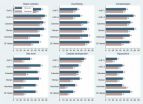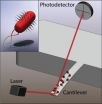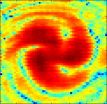(Press-News.org) San Francisco, September 15, 2014—Patients with inoperable, early-stage lung cancer who receive stereotactic body radiation therapy (SBRT) have a five-year survival rate of 40 percent, according to research presented today at the American Society for Radiation Oncology's (ASTRO's) 56th Annual Meeting. Such a positive survival rate is encouraging considering that historically conventional RT resulted in poor tumor control for patients with inoperable lung cancer. This study is an update of RTOG 0236, originally published in 2010 , and also conducted by the original researchers to evaluate tumor control rates and side effects for patients at five years post-treatment.
RTOG 0236 was a Phase II North American multicenter trial from May 2004 until October 2006 of patients age 18 and older with biopsy-proven peripheral T1-T2 N0M0 non-small cell lung cancer (early stage with no lymph node involvement or metastases). Patients in the study all had medical conditions that precluded them from surgery, so they received SBRT, a specialized type of external beam therapy that uses focused radiation beams at a tumor using detailed imaging. SBRT delivers high doses of radiation to the tumor in a decreased amount of treatment time, compared to standard RT, while minimizing exposure to surrounding healthy organs. SBRT appeared to improve tumor control, as suggested by the initial study results for RTOG 0236.
A total of 59 patients were accrued for the study, and 55 were evaluable (44 patients with T1 tumors and 11 patients with T2 tumors). Patients each received three fractions of 18 Gy (54 Gy total) of SBRT, and treatment lasted between one-and-a-half to two weeks.
Researchers evaluated local control, which is the rate of reoccurrence of the cancer at the site of origin, as well as disease-free survival, overall survival and toxicity (side effects). Median follow-up was four years (7.2 years for surviving patients). At five years, the rates for disease-free and overall survival were 26 percent and 40 percent, respectively, with a median overall survival of four years.
Only four patients had recurrences at the primary tumor site, resulting in an estimated five-year primary tumor failure rate of seven percent (range, 1.8 to 4.8 years after SBRT). Nine additional patients had recurrence within the involved lobe (range, 0.1 to 5.9 years after SBRT), resulting in a five-year primary tumor and involved lobe (local) failure rate of 20 percent.
The five-year local-regional failure rate was 38 percent, of which seven patients experienced a spread of the cancer to nearby lymph nodes or organs (range, 2.8 to 5.2 years after SBRT). Fifteen patients had disseminated recurrence (throughout the lung), thus the five-year disseminated failure rate was 31 percent. Treatment-related grade three and grade four side effects were reported in 15 patients and in two patients, respectively. No grade five adverse events were reported.
"Historically, when treating early lung cancer with radiotherapy, progression at the site of the primary tumor was the most common failure resulting in suffering and death," said lead study author Robert Timmerman, MD, professor and vice chair of the department of radiation oncology at the University of Texas Southwestern Medical Center in Dallas. "The initial results of RTOG 0236 showed very good tumor control; however, many physicians were concerned that treatment-related toxicity would eventually appear, so SBRT has not seen wide-spread use. This long-term analysis confirms that treated tumors did not reappear at the original site; and late toxicity, beyond what was seen in the initial report, did not appear. However, metastatic tumors continued to appear over time in untreated sites likely because those tumors were so small at initial treatment that they were not detected. These five-year results demonstrate positive tumor control and disprove the misconception that short-course treatment will result in late-appearing, unacceptable toxicities."
INFORMATION:
The abstract, "Long-term Results of RTOG 0236: A Phase II Trial of Stereotactic Body Radiation Therapy (SBRT) in the Treatment of Patients with Medically Inoperable Stage I Non-Small Cell Lung Cancer," will be presented in detail during a scientific session at ASTRO's 56th Annual Meeting at 10:45 a.m. Pacific time on Monday, September 15, 2014. To speak with Dr. Timmerman, please call Michelle Kirkwood on September 14 – 17, 2014, in the ASTRO Press Office at San Francisco's Moscone Center at 415-978-3503 or415-978-3504, or email michellek@astro.org.
ASTRO's 56th Annual Meeting, to be held at the Moscone Center in San Francisco, September 14-17, 2014, is the nation's premier scientific meeting in radiation oncology. The 2014 Annual Meeting is expected to attract more than 11,000 attendees including oncologists from all disciplines, medical physicists, dosimetrists, radiation therapists, radiation oncology nurses and nurse practitioners, biologists, physician assistants, practice administrators, industry representatives and other health care professionals from around the world. Led by ASTRO President Bruce G. Haffty, MD, FASTRO, a radiation oncologist specializing in breast cancer, the theme of the 2014 Meeting is "Targeting Cancer: Technology and Biology," and the Presidential Symposium, "Local-regional Management of Breast Cancer: A Changing Paradigm," will feature Jay R. Harris, MD, FASTRO, and Thomas A. Buchholz, MD, FASTRO, to highlight recent practice-changing, landmark studies and current developments in the local-regional management of breast cancer. ASTRO's four-day scientific meeting includes presentation of up to four plenary papers, 360 oral presentations, 1,862 posters and 144 digital posters in more than 50 educational sessions and scientific panels for 20 disease-site tracks. Three keynote speakers will address a range of topics including oncologic imaging, biology and targeting in oncology, and human error and safety concerns: Hedvig Hricak, MD, PhD, Chair of the Department of Radiology and the Carroll and Milton Petrie Chair at Memorial Sloan Kettering Cancer Center; Frank McCormick, PhD, FRS, DSc (hon), Professor Emeritus and the David A. Wood Distinguished Professor of Tumor Biology and Cancer Research of the University of California at San Francisco Helen Diller Family Comprehensive Cancer Center; and Sidney Dekker, PhD, MA, MSc, Professor and Director of the Safety Science Innovation Lab at Griffith University, Brisbane, Australia.
About ASTRO
ASTRO is the premier radiation oncology society in the world, with more than 10,000 members who are physicians, nurses, biologists, physicists, radiation therapists, dosimetrists and other health care professionals that specialize in treating patients with radiation therapies. As the leading organization in radiation oncology, the Society is dedicated to improving patient care through professional education and training, support for clinical practice and health policy standards, advancement of science and research, and advocacy. ASTRO publishes two medical journals, International Journal of Radiation Oncology • Biology • Physics and Practical Radiation Oncology; developed and maintains an extensive patient website, http://www.rtanswers.org; and created the Radiation Oncology Institute, a non-profit foundation to support research and education efforts around the world that enhance and confirm the critical role of radiation therapy in improving cancer treatment. To learn more about ASTRO, visit http://www.astro.org.
2014 American Society for Radiation Oncology (ASTRO) 56th Annual Meeting
News Briefing, Tuesday, September 16, 2014, 7:00 a.m. Pacific time
Scientific Session: Monday, September 15, 2014, 10:45 a.m. – 12:15 p.m. PT, the Moscone Center
3682 Long-term Results of RTOG 0236: A Phase II Trial of Stereotactic Body Radiation Therapy (SBRT) in the Treatment of Patients with Medically Inoperable Stage I Non-Small Cell Lung Cancer
Author Block: R. D. Timmerman1, C. Hu2, J. Michalski3, W. Straube3, J. Galvin4, D. Johnstone5, J. Bradley3, R. Barriger6, A. Bezjak7, G. M. Videtic8, L. Nedzi1, M. Werner-Wasik4, Y. Chen9, R. U. Komaki10, H. Choy1, 1University of Texas Southwestern Medical School, Dallas, TX, 2American College of Radiology, Philadelphia, PA, 3Washington University Medical Center, St. Louis, MO, 4Thomas Jefferson Hospital, Philadelphia, PA, 5Medical College of Wisconsin, Milwaukee, WI, 6Indiana University Medical Center, Indianapolis, IN, 7Princess Margaret Hospital, Toronto, ON, 8Cleveland Clinic, Cleveland, OH, 9University of Rochester Medical Center, Rochester, NY, 10M.D. Anderson Cancer Center, Houston, TX
Purpose/Objective(s): Patients with early stage but medically inoperable lung cancer historically had poor primary tumor control and high mortality with conventional radiotherapy. SBRT appeared to improve outcomes, as suggested by the initial published results of RTOG 0236. Herein, we update those results with longer follow-up.
Materials/Methods: The study was a Phase 2 North American multicenter study of patients aged 18 years or older with biopsy-proven peripheral T1-T2N0M0 non-small cell tumors (measuring ≤5 cm in diameter) and medical conditions precluding surgical treatment. The prescription dose was 18 Gy per fraction X 3 fractions (54 Gy total) with entire treatment lasting between 1½ and 2 weeks. The study opened May 26, 2004, and closed October 13, 2006; data were analyzed through October 15, 2013. The primary end point was 2-year actuarial primary tumor control; secondary end points were disease-free survival (i.e., primary tumor, involved lobe, regional, and disseminated recurrence), treatment-related toxicity, and overall survival.
Results: A total of 59 patients accrued, of which 55 were evaluable (44 patients with T1 tumors and 11 patients with T2 tumors) with a median follow-up of 4.0 years (7.2 years for surviving patients). Four patients had an in-field/marginal (primary) tumor failure (range, 1.8-4.8 years after SBRT); the estimated 5-year primary tumor failure rate was 7%. Nine additional patients had recurrence within the involved lobe (range 0.1-5.9 years after SBRT); the 5-year primary tumor and involved lobe (local) failure rate was 20%. Seven patients experienced regional failure (range, 2.8-5.2 years after SBRT); the 5-year local-regional failure rate was 38%. Fifteen patients experienced disseminated recurrence; the 5-year disseminated failure rate was 31%. The rates for disease free and overall survival at 5 years were 26% and 40%, respectively. The median overall survival was 4 years. Protocol treatment-related grade 3 and 4 adverse events were reported in 15 patients and in 2 patients, respectively, modestly more than was described in the previous 3-year report. No grade 5 adverse events were reported.
Conclusions: Patients with inoperable non-small cell lung cancer treated with SBRT had a survival rate of 40% at 5 years. While tumor control rates remain high compared to conventional fractionation results, late failures were observed particularly in the involved (untreated) residual lobe. However, an excess of late-appearing toxicity was not observed.
Author Disclosure Block: R.D. Timmerman: E. Research Grant; Varian Medical Systems. C. Hu: None. J. Michalski: None. W. Straube: None. J. Galvin: None. D. Johnstone: None. J. Bradley: None. R. Barriger: None. A. Bezjak: None. G.M. Videtic: None. L. Nedzi: None. M. Werner-Wasik: None. Y. Chen: None. R.U. Komaki: None. H. Choy: None.
Long-term results of RTOG 0236 confirm good primary tumor control, positive 5-year survival rates
For lung cancer patients who received stereotactic body radiation therapy
2014-09-16
ELSE PRESS RELEASES FROM THIS DATE:
Politics divide coastal residents' views of environment, UNH research finds
2014-09-16
DURHAM, N.H. – From the salmon-rich waters of Southeast Alaska to the white sand beaches of Florida's Gulf Coast to Downeast Maine's lobster, lumber and tourist towns, coastal residents around the U.S. share a common characteristic: their views about coastal environments divide along political lines. That's a primary finding of a new study by University of New Hampshire sociologists published this month in the journal Society & Natural Resources.
"We found a lot of environment-related differences from place to place to place. Each environment is different so that's just ...
Artworks are people!
2014-09-16
Not all things are created equally. We don't view a Picasso sculpture in the same way we look at a hammer, for example — no matter how fancy the hammer.
The reason? We see the Picasso more as a person than an object, according to new research from the University of Chicago Booth School of Business.
And in some cases, we make distinctions between artworks — say, an exact replica of a piece created by the artist, versus one created by a different artist.
Art, in other words, is an extension of the creator, write Professor Daniel M. Bartels of Chicago Booth, and Professor ...
For electronics beyond silicon, a new contender emerges
2014-09-16
Cambridge, Mass. – September 16, 2014 – Silicon has few serious competitors as the material of choice in the electronics industry. Yet transistors, the switchable valves that control the flow of electrons in a circuit, cannot simply keep shrinking to meet the needs of powerful, compact devices; physical limitations like energy consumption and heat dissipation are too significant.
Now, using a quantum material called a correlated oxide, Harvard researchers have achieved a reversible change in electrical resistance of eight orders of magnitude, a result the researchers ...
NASA's Global Hawk and satellites investigating Hurricane Edouard today
2014-09-16
The unmanned Global Hawk aircraft that's part of NASA's airborne Hurricane and Severe Storm Sentinel, or HS3 mission was winging its way to Hurricane Edouard on September 16. In addition to the Global Hawk, various NASA satellites are continually providing data on the Atlantic hurricane.
Scientific instruments aboard NASA's remotely piloted Global Hawk aircraft have been studying the hurricane over the last couple of days, and the Global Hawk returned to Edouard again today, September 16. Two of the instruments aboard the Global Hawk that will study Edouard are the S-HIS ...
Cancer patients with malignant spinal cord compression have preserved mobility
2014-09-16
San Francisco, September 15, 2014—Mobility is equally preserved in cancer patients suffering from malignant spinal cord compression (MSCC) who receive a single dose of 10 Gy of radiation therapy (RT), compared to patients who receive five daily doses of 4 Gy of RT each, according to research presented today at the American Society for Radiation Oncology's (ASTRO's) 56th Annual Meeting.
Malignant spinal cord compression (MSCC) is a complication of metastatic cancer mostly with bone involvement that occurs when a tumor's secondary deposit presses on the spinal cord and ...
And so they beat on, flagella against the cantilever
2014-09-16
WASHINGTON D.C., September 16, 2014 – A team of researchers at Boston University and Stanford University School of Medicine has developed a new model to study the motion patterns of bacteria in real time and to determine how these motions relate to communication within a bacterial colony.
The researchers chemically attached colonies of Escherichia coli bacteria to a microcantilever – a microscopic beam anchored at one end, similar to a diving board – thus coupling its motion to that of the bacteria. As the cantilever itself isn't doesn't generate any vibrations, or 'noise,' ...
NASA sees Tropical Storm Odile knocking at US Southwest
2014-09-16
Tropical Storm Odile continues to drench western Mexico and has now entered into the U.S. Southwest. On September 15, NASA's Terra satellite saw Odile's northernmost edge crossing the Mexican border into southern California. NOAA's GOES-East satellite on September 16 showed Odile's outer bands were already bringing storms to southern Arizona.
NASA Sees Odile Knocking on U.S. Border
On Sept. 15 at 2:35 p.m. EDT, the Moderate Resolution Imaging Spectroradiometer instrument aboard NASA's Terra satellite saw the northern fringes of Hurricane Odile straddling the border ...
Scientists twist radio beams to send data
2014-09-16
Building on previous research that twisted light to send data at unheard-of speeds, scientists at USC have developed a similar technique with radiowaves, reaching high speeds without some of the hassles that can go with optical systems.
The researchers, led by electrical engineering professor Alan Willner of the USC Viterbi School of Engineering, reached data transmission rates of 32 gigabits per second across 2.5 meters of free space in a basement lab at USC.
For reference, 32 gigabits per second is fast enough to transmit more than 10 hour-and-a-half-long HD movies ...
Kessler Foundation scientists link slowed processing speed with executive deficits in MS
2014-09-16
West Orange, NJ. September 16, 2014. Kessler Foundation researchers have published a study supporting the role of slowed processing speed in the executive deficits found in individuals with multiple sclerosis (MS). "Does slowed processing speed account for executive deficits in multiple sclerosis? Evidence from neuropsychological performance and structural neuroimaging," was published online ahead of print on August 18 by Rehabilitation Psychology The authors are Victoria Leavitt, PhD, of the Manhattan Memory Center, formerly of Kessler Foundation. Co-authors are Foundation ...
Tornadoes occurring earlier in 'Tornado Alley'
2014-09-16
WASHINGTON, D.C. – Peak tornado activity in the central and southern Great Plains of the United States is occurring up to two weeks earlier than it did half a century ago, according to a new study whose findings could help states in "Tornado Alley" better prepare for these violent storms.
Tornado records from Nebraska, Kansas, Oklahoma, and northern Texas – an area of high tornado activity dubbed "Tornado Alley" -- show that peak tornado activity is starting and ending earlier than it did 60 years ago.
Peak tornado activity, which occurs in the region from early ...
LAST 30 PRESS RELEASES:
Scalable and healable gradient textiles for multi‑scenario radiative cooling via bicomponent blow spinning
Research shows informed traders never let a good climate crisis go to waste
Intelligent XGBoost framework enhances asphalt pavement skid resistance assessment
Dual-function biomaterials for postoperative osteosarcoma: Tumor suppression and bone regeneration
New framework reveals where transport emissions concentrate in Singapore
NTP-enhanced lattice oxygen activation in Ce-Co catalysts for low-temperature soot combustion
Synergistic interface engineering in Cu-Zn-Ce catalysts for efficient CO2 hydrogenation to methanol
COVID-19 leaves a lasting mark on the human brain
Scientists use ultrasound to soften and treat cancer tumors without damaging healthy tissue
Community swimming program for Black youth boosts skills, sense of belonging, study finds
Specific depressive symptoms in midlife linked to increased dementia risk
An ‘illuminating’ design sheds light on cholesterol
Who is more likely to get long COVID?
Study showcases resilience and rapid growth of “living rocks”
Naval Research Lab diver earns Office of Naval Research 2025 Sailor of the Year
New Mayo-led study establishes practical definition for rapidly progressive dementia
Fossil fuel industry’s “climate false solutions” reinforce its power and aggravate environmental injustice
Researchers reveal bias in a widely used measure of algorithm performance
Alcohol causes cancer. A study from IOCB Prague confirms damage to DNA and shows how cells defend against it
Hidden viruses in wastewater treatment may shape public health risks, study finds
Unlock the power of nature: how biomass can transform climate mitigation
Biochar reshapes hidden soil microbes that capture carbon dioxide in farmland
Reducing saturated fat intake shows mortality benefit, but only in high-risk individuals
Manta rays create mobile ecosystems, study finds
Study: Mixed results in using lipoic acid to treat progressive multiple sclerosis
Norbert Holtkamp appointed director of Fermi National Accelerator Laboratory
New agentic AI platform accelerates advanced optics design
Biologists discover neurons use physical signals — not electricity — to stabilize communication
Researchers discover that a hormone can access the brain by hitchhiking
University of Oklahoma researcher awarded funding to pursue AI-powered material design
[Press-News.org] Long-term results of RTOG 0236 confirm good primary tumor control, positive 5-year survival ratesFor lung cancer patients who received stereotactic body radiation therapy






